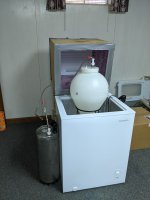The only way I can answer this is to ask you back - “What do you like to drink?” That’s the beauty of this hobby. You can brew whatever you want, within reason.
Some things to take into account would be whether you have any grain on hand you want to use, or if you have a particular yeast on hand you want to use. Or if there’s a particular hop you want to try.
That’s kind of how I approach planning my brews. I usually start with the yeast, as its the most important thing. People make wort, yeast makes beer. Each yeast has a range of “recommended” beers it can produce. I’m a Wyeast guy. If I have 1056, I’m making American Pale Ale, Amber Ale, IPA, possibly American Stout or Barleywine. If I have 1028 or 1099, I’m making bitter and English Pale Ale, possibly Porter or Dry Stout. I’m not a real big dark beer drinker but my wife likes them and I do enjoy them occasionally. I plan the recipes in order, light to dark, weak to strong and try to brew 4 or 5 beers in an order that makes sense re-using the same yeast.
I take seasons into account also. I’m probably not drinking much barleywine or porter in the summer. I want lighter ales. I plan the stronger beers to have in the winter when its cold outside. It’s mid May, so if I’m brewing today I ask myself “What do I want to be drinking at the end of June, early July?”
There’s no right answer here - it’s whatever you want to do.












![Craft A Brew - Safale BE-256 Yeast - Fermentis - Belgian Ale Dry Yeast - For Belgian & Strong Ales - Ingredients for Home Brewing - Beer Making Supplies - [3 Pack]](https://m.media-amazon.com/images/I/51bcKEwQmWL._SL500_.jpg)













































